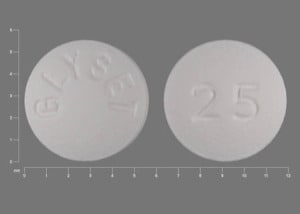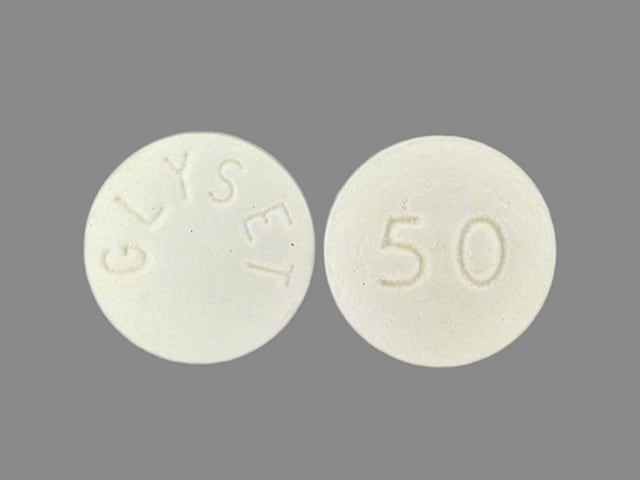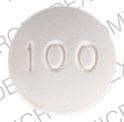Glyset
Generic name: miglitol
Drug class: Alpha-glucosidase inhibitors
Medically reviewed by A Ras MD.
What is Glyset used for?
Glyset is a prescription medicine that is used to lower blood sugar in patients with high blood sugar (diabetes).
Description
GLYSET Tablets contain miglitol, an oral alpha-glucosidase inhibitor for use in the management of non-insulin-dependent diabetes mellitus (NIDDM). Miglitol is a desoxynojirimycin derivative, and is chemically known as 3,4,5-piperidinetriol, 1-(2-hydroxyethyl)-2-(hydroxymethyl)-, [2R-(2α,3β,4α, 5β)]-. It is a white to pale-yellow powder with a molecular weight of 207.2. Miglitol is soluble in water and has a pKa of 5.9. Its empirical formula is C8H17NO5 and its chemical structure is as follows:
 |
GLYSET is available as 25 mg, 50 mg and 100 mg tablets for oral use. The inactive ingredients are starch, microcrystalline cellulose, magnesium stearate, hypromellose, polyethylene glycol, titanium dioxide, and polysorbate 80.
Before taking Glyset, tell your doctor:
- If you are allergic to Glyset; any part of this medicine; or any other drugs, foods, or substances. Tell your doctor about the allergy and what signs you had.
- If you have any of these health problems: Bowel block or at risk for bowel block, bowel problems like inflammatory bowel disease, diabetic acid problems, malabsorption syndrome, problems with food break down, or ulcers in the colon.
- If you have kidney disease.
- If you are breast-feeding. Do not breast-feed while you take Glyset.
This is not a list of all drugs or health problems that interact with this medicine.
Tell your doctor and pharmacist about all of your drugs (prescription or OTC, natural products, vitamins) and health problems. You must check to make sure that it is safe for you to take Glyset with all of your drugs and health problems. Do not start, stop, or change the dose of any drug without checking with your doctor.
What are some things I need to know or do while I take Glyset?
- Tell all of your health care providers that you take Glyset. This includes your doctors, nurses, pharmacists, and dentists.
- Do not drive if your blood sugar has been low. There is a greater chance of you having a crash.
- Check your blood sugar as you have been told by your doctor.
- Have blood work checked as you have been told by the doctor. Talk with the doctor.
- Follow the diet and workout plan that your doctor told you about.
- It may be harder to control blood sugar during times of stress such as fever, infection, injury, or surgery. A change in physical activity, exercise, or diet may also affect blood sugar.
- Tell your doctor if you are pregnant or plan on getting pregnant. You will need to talk about the benefits and risks of using Glyset while you are pregnant.
How is Glyset best taken?
Use Glyset as ordered by your doctor. Read all information given to you. Follow all instructions closely.
- Take with the first bite of each meal.
- Keep taking Glyset as you have been told by your doctor or other health care provider, even if you feel well.
- If you take charcoal or digestive enzyme preparations, talk to your doctor about how to take them with Glyset.
What do I do if I miss a dose?
- Skip the missed dose and go back to your normal time.
- Do not take 2 doses at the same time or extra doses.
What are the side effects of Glyset that I need to call my doctor about immediately?
WARNING/CAUTION: Even though it may be rare, some people may have very bad and sometimes deadly side effects when taking a drug. Tell your doctor or get medical help right away if you have any of the following signs or symptoms that may be related to a very bad side effect:
- Signs of an allergic reaction, like rash; hives; itching; red, swollen, blistered, or peeling skin with or without fever; wheezing; tightness in the chest or throat; trouble breathing, swallowing, or talking; unusual hoarseness; or swelling of the mouth, face, lips, tongue, or throat.
- Low blood sugar can happen. The chance may be raised when Glyset is used with other drugs for diabetes. Signs may be dizziness, headache, feeling sleepy or weak, shaking, fast heartbeat, confusion, hunger, or sweating. Call your doctor right away if you have any of these signs. Follow what you have been told to do for low blood sugar. This may include taking glucose tablets, liquid glucose, or some fruit juices.
What are some other side effects of Glyset?
All drugs may cause side effects. However, many people have no side effects or only have minor side effects. Call your doctor or get medical help if any of these side effects or any other side effects bother you or do not go away:
- Belly pain.
- Diarrhea.
- Gas.
These are not all of the side effects that may occur. If you have questions about side effects, call your doctor. Call your doctor for medical advice about side effects.
You may report side effects to the FDA at 1-800-332-1088. You may also report side effects at https://www.fda.gov/medwatch.
If overdose is suspected:
If you think there has been an overdose, call your poison control center or get medical care right away. Be ready to tell or show what was taken, how much, and when it happened.
Glyset Images
-

Glyset 25 mg -

Glyset 50 mg -

Glyset 100 mg
How do I store and/or throw out Glyset?
- Store at room temperature.
- Store in a dry place. Do not store in a bathroom.
- Keep all drugs in a safe place. Keep all drugs out of the reach of children and pets.
- Throw away unused or expired drugs. Do not flush down a toilet or pour down a drain unless you are told to do so. Check with your pharmacist if you have questions about the best way to throw out drugs. There may be drug take-back programs in your area.
SRC: NLM .
